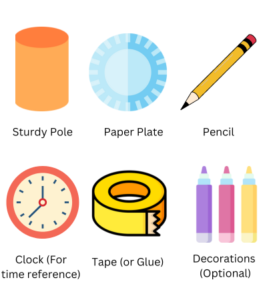
Time Travelers: Building a Homemade Sundial!
Description: Embark on a journey through time with the power of the sun! In this exciting experiment, you will create your very own sundial to track the movement of the sun and tell time like ancient civilizations did. Learn about the Earth’s rotation, the concept of shadows, and how the position of the sun changes throughout the day. Get ready to unlock the secrets of timekeeping with a simple and fascinating homemade sundial!
Scientific Principles:
- Earth’s Rotation: The experiment will teach you about the Earth’s rotation, which causes the sun to appear to move across the sky during the day.
- Shadows and Sun’s Position: By observing the shadow cast by the sundial, you will learn how the sun’s position changes throughout the day and how shadows can be used to track time.
Equipment Needed:
- A sturdy stick or pole (about 1 foot tall)
- A circular object (e.g., paper plate, plastic lid, or cardboard)
- Pencil or marker
- Tape or glue
- Watch or clock for time reference
- Optional: Decorative materials (e.g., stickers, markers, or paint) for extra creativity
Difficulty Ratings: Equipment: ★☆☆☆☆ (1/5) Experiment: ★★☆☆☆ (2/5)

Experiment Description:
- Step 1: Get ready! Gather all the materials listed above and find a sunny outdoor area where you can conduct your experiment. Make sure you have a clear view of the sky and an open space to place your sundial.
- Step 2: Building the Sundial: a) Place the circular object (paper plate, plastic lid, or cardboard) on a flat surface outdoors. b) Use the pencil or marker to mark the center of the circular object. c) Take the stick or pole and position it vertically at the center of the circular object. Make sure it stands straight and doesn’t wobble. Use tape or glue to secure it in place. This stick or pole is the gnomon of your sundial, which casts a shadow.
- Step 3: Marking the Hours: a) Pick a time to start your experiment, for example, 9:00 a.m. b) Look at your watch or clock to see where the shadow of the gnomon falls on the circular object at that time. Use the pencil or marker to mark that spot on the circular object. This is the position of the shadow at 9:00 a.m. c) Repeat this step every hour throughout the day, marking the position of the shadow on the circular object for each hour. For example, mark the positions at 10:00 a.m., 11:00 a.m., and so on. Make sure to align the marks with the shadow cast by the gnomon accurately.
- Step 4: Observing and Telling Time: a) Once you have marked several positions of the shadow on the circular object, you can use these marks as reference points to tell the time. For example, if the shadow aligns with the mark you made at 12:00 p.m., it’s noon! b) Throughout the day, observe how the shadow moves across the circular object and aligns with different marks, indicating the passage of time.
- Step 5: Optional: Decorate Your Sundial: If you like, use decorative materials like stickers, markers, or paint to make your sundial colorful and personalized. Let your creativity shine as you design your own unique timekeeping device!
Safety Tip: Remember to conduct the experiment in a safe outdoor area and protect yourself from the sun by wearing a hat, sunscreen, and appropriate clothing.
Simple Explanation:
A sundial helps us tell time using the sun’s position and shadows. When the sun shines, it makes a stick or pole (the gnomon) cast a shadow on a circle. As the sun moves across the sky, the shadow moves too! We mark the shadow’s position on the circle at different times of the day. By looking at where the shadow falls, we can tell what time it is. It’s like having a special clock powered by the sun!


Detailed Explanation:
A sundial works based on the movement of the Earth and the position of the sun. The Earth rotates on its axis, making the sun appear to move across the sky during the day. As the sun moves, it casts a shadow from the gnomon of the sundial onto the circular object. The length and direction of the shadow change as the sun’s position changes.
The marks we make on the circular object represent specific hours of the day. When we align the shadow with the marks, we can tell the approximate time based on where the shadow falls. The sundial helps us understand how the Earth’s rotation and the sun’s position affect the movement of shadows, allowing us to track the passage of time in a unique and fascinating way.

